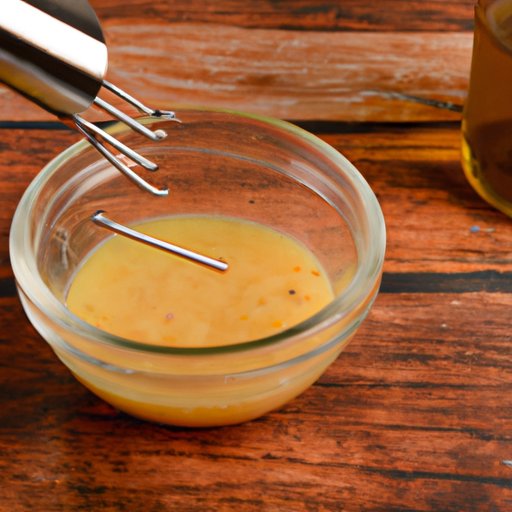Introduction
Gravy is an essential part of any good meal, adding flavor and moisture to meats and vegetables. Making gravy from drippings is an excellent way to maximize the flavor of your dish while minimizing food waste. In this article, we’ll explore how to make gravy from drippings, including tips for beginners, best recipes, seasoning options, nutritional benefits, and more.
Step-by-Step Guide
Making gravy from drippings is a simple process that requires only a few ingredients and tools. Here’s how to do it:
- After cooking your meat or vegetables, remove them from the pan and place them on a plate. Reserve any remaining juices, fat, and bits left in the pan as they will be the basis of your gravy.
- Place the roasting pan on the stove and set the heat to medium-high. Add a tablespoon of flour to the pan drippings and stir continuously until it forms a paste. Cook for a minute or two to remove any raw flour taste.
- Slowly add stock or broth to the pan drippings, stirring constantly to prevent lumps. You can use chicken, beef, or vegetable stock, depending on what kind of gravy you want to make.
- Bring the mixture to a boil, then reduce the heat and let it simmer for a few minutes until it thickens. Continue stirring until the gravy reaches your desired consistency.
- Season the gravy with salt, pepper, and any other herbs or spices you like. Taste and adjust the seasoning as needed.
- If the gravy is too thick, add more stock or broth to thin it out. If it’s too thin, simmer it for a bit longer until it reduces and thickens.
- Once the gravy is ready, pour it over your meat or vegetables, and serve immediately.
Remember to be patient and stir the gravy often to avoid lumps and burning. If things go awry, don’t worry – we’ll provide some troubleshooting tips later in this article.
Beginner’s Guide
If you’re new to cooking with drippings, don’t worry! Here are a few tips to help you get started:
- Drippings are the juices, fats, and caramelized bits left at the bottom of a pan after cooking meat or vegetables. They add a depth of flavor to sauces, soups, and gravies.
- To collect drippings, remove the cooked meat or vegetables from the pan and pour the remaining juices into a measuring cup. Skim off any excess fat with a spoon or gravy separator.
- Not all drippings are created equal. Depending on the type of meat or vegetable you’re using, you may find that some drippings work better for gravy than others. For example, beef drippings tend to create a richer, more flavorful gravy than chicken drippings.
Best Recipes
Here are some popular recipes for making gravy from drippings:
Turkey Gravy
- 1/4 cup turkey drippings
- 1/4 cup flour
- 2 cups chicken stock
- Salt and pepper to taste
To make turkey gravy, follow the steps outlined in the step-by-step guide above, using the turkey drippings as the base. You can also add a splash of white wine for extra flavor.
Beef Gravy
- 1/4 cup beef drippings
- 1/4 cup flour
- 2 cups beef stock
- Salt and pepper to taste
- 1/4 cup red wine (optional)
To make beef gravy, follow the same steps as above, using beef drippings and beef stock as your base. You can also add some red wine for a richer flavor.
Vegetarian Gravy
- 1/4 cup vegetable drippings (such as mushroom or onion)
- 1/4 cup flour
- 2 cups vegetable broth
- Salt and pepper to taste
To make vegetarian gravy, use vegetable drippings as your base and vegetable broth instead of chicken or beef stock. You can also add some herbs like thyme or rosemary for extra flavor.
Tips and Tricks
Here are a few tips and tricks to enhance the flavor and texture of your gravy:
- Season your gravy with fresh herbs like parsley, thyme, or rosemary.
- Add some acidity to your gravy with a splash of balsamic vinegar, white wine, or lemon juice.
- If your gravy is too salty, add a splash of vinegar or sugar to balance it out.
- If your gravy is too thin, you can thicken it with a cornstarch slurry or a roux (equal parts flour and butter).
- If your gravy is lumpy, strain it through a fine-mesh strainer or use an immersion blender to smooth it out.
Nutritional Benefits
In addition to adding flavor to your meals, using drippings in your gravy can provide some nutritional benefits. Drippings are an excellent source of protein, B vitamins, and minerals like iron and zinc. However, they can also be high in fat and sodium, so it’s important to use them in moderation and balance them with other healthy foods.
Conclusion
Making gravy from drippings is a simple yet satisfying way to elevate your meals. Whether you’re a beginner cook or a seasoned pro, these tips and guidelines will help you create delicious, flavorful gravy every time. Don’t be afraid to experiment with different types of drippings, seasonings, and recipes to find the perfect gravy for your dish.
